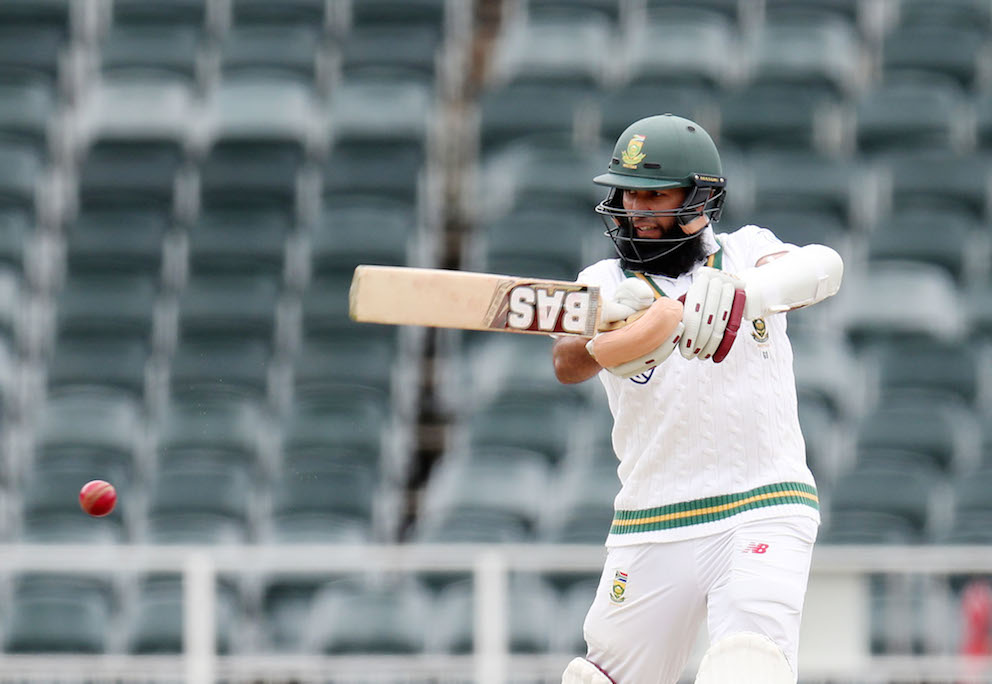South Africa’s premier batsman Hashim Amla still has an appetite for runs which suggests he is nowhere near finished his job for the Proteas.
In a high-octane series that was never short of drama, where ill-judged actions led to life-changing consequences, and every session, let alone match, created its own headline, for 46.2 overs on the second day of the second Test in Port Elizabeth it seemed as if time was standing still.
South Africa had once again been caught napping in a series opener the previous week in Durban. All the pre-series warnings from former captain Graeme Smith to this very writer about not allowing Australia to get the early ascendency had fallen on deaf ears.
At least Faf du Plessis’ Proteas were not prepared to be ‘bullied’, with Quinton de Kock retaliating to David Warner’s constant barraging – although the fracas that ensued within the Kingsmead corridors set in motion a course of events so toxic that pay-channel SuperSport deemed it box-office enough to later produce a documentary, Crossing the Line, showcasing all the palaver in graphic detail.
But for 203 minutes, at the venerable venue where Test cricket was born in this country, it was a period of satisfaction for the purist focused solely on the cricket. In the process, it had a huge impact in allowing the Proteas to claw their way back into the series. There were no sideshows – besides Sri Lankan umpire Kumar Dharmasena’s Stalinist-obsession in trying to silence the St George’s Park band – with the battle between bat and the reverse-swinging ball taking prominence.
Only later would we discover Australia’s underhand tactics in getting the red Kookaburra to bend around corners, but at the time of watching, the skill of the visitors’ ‘Big Three’ of Mitchell Starc, Josh Hazlewood and Pat Cummins could only be admired. They threw all their might at the home side, for they knew if they could break the stubborn resistance of Dean Elgar and a certain Hashim Amla, the writing would be on the wall for the Proteas and normal service would resume.
It was not to be, though, for they were met with a granite wall that refused to crack. It was an engrossing passage of play that was tense and attritional – the sort of Test cricket’s originators England have become immune to playing under Ted Bayliss and certainly have no intention of returning to especially with the advent of 100-ball cricket.
It was a master class in restraint of trade which replaced silky wrist-play with stoic defence and sweetly timed drives with studious caution. The magnitude of the session, not only in the context of the Test, but also the series, was acknowledged in the aftermath, especially by Du Plessis in his praise of Amla’s contribution.
Only after a magical ball from the left-arm of Starc, delivered wide of the crease that was on course for middle stump, which straightened ever so late to pass Amla’s outside edge and crash into the top of middle stump was the resistance ended.
On the scoreboard, it may only have been 56 runs, but its currency was invaluable. By then the bedrock had been laid for the now-retired AB de Villiers to engrave his name into the storied annals of Proteas cricket with a mesmerising innings, that ultimately culminated in the record books being torn up at the Wanderers a couple of weeks later when South Africa celebrated their first series victory over their arch-rivals on home soil post-unity.
It had all the elements of a tale told so often before, though. Not only in the trenches of Test cricket, but also under the bright lights of ODIs. Amla’s numbers may not be as striking and headline-piercing as before, but he remains the foundation of the Proteas batting lineup.
Equally, with close on 9,000 Test runs, he is also the premier artisan. And in De Villiers’ absence, comfortably the most experienced too. An undoubted leader within the Proteas dressing room, best illustrated when it was Amla who fronted up with the entire team in tow to the Australian press contingent, in defence of Du Plessis’ ‘Mintgate’ allegations on the outskirts of the MCG outfield in 2016. These are values that cannot be underestimated – let alone taken for granted.
‘Hashim brings a lot of solidity and plenty of calmness to the Proteas team. When he is in control of the situation, everyone feeds off it and it creates a lot of confidence in the dressing room,’ says Cape Cobras coach and former Proteas batsman Ashwell Prince. ‘For all AB’s brilliance, and even throughout his illustrious career, I always thought he performed well when Hashim laid the foundation upfront.’
The term ‘calmness’ is an oft-description of Amla’s virtues, with Prince not isolated in his assessment. Champion fast bowler Dale Steyn is a further card-carrying member of the Amla admiration society.
‘I find that Hash has always brought a sense of calm to the team,’ Steyn said. ‘We all have our ways but to remain calm in extreme situations is an incredible strength. He’s also never shy of a bit of humour‚ very smart and calculated in his approach‚ he always brings a smile to the guys’ faces.’
These are all hugely admirable qualities, but the aura that surrounds Amla has not been forged through his comedy routine. That is due to his insatiable appetite for runs – big runs.
At the crescendo of his powers, between 2012 and 2014, Amla piled on 2 397 Test runs at an average of 64.78. All the idiosyncrasies of his technique were adored: the crooked backlift, the exaggerated trigger movement across off stump, the free-flowing hands away from the body and the swiftness of his bat speed. However, after experiencing the leanest year of his Test career since a tentative start in 2004-05 this past season, the microscope has once again been placed over Amla’s technique. Only now, the lingering question is whether it is the first signs of fading brilliance.
‘I think this will always happen. When he’s scoring runs, the technique is fine, but when he’s not then it poses a problem. That’s just how it is,’ Prince explained, before admitting to some concern.
‘I think Hashim is more than capable of returning to his best form. But if you have been watching him closely, he has been fiddling around with his technique, the trigger movement especially over the past year. I think it’s a rhythm thing. It is not really a footwork thing. If he manages to find his rhythm again, everything will be fine.’
Observation of Amla’s preparation gives the impression he is acutely aware of his current shortcomings and more importantly has the desire to set it straight. The senior statesman of the Proteas team is often last to leave the nets, regularly requesting extra throw downs from the support staff. Equally, he spends hours with video analyst and resident ‘stats guru’ Prasanna ‘P-Dogg’ Agoram.
With a full Sri Lanka tour on the horizon and South Africa looking to continue their winning streak on the tea-loving island after Amla led the Proteas to their a series victory there in 2014 for the first time since the Brett Schultz-inspired success 20 years previously, Prince believes it may be a blessing in disguise that Amla was overlooked for the Indian Premier League this year.
Because instead of wallowing about the fact that despite being the highest run-scorer, which included two centuries, for Kings XI Punjab in 2017 did not warrant a recall to grandest show in cricket, Amla merely swapped the north of India for the south of England.
The Rose Bowl has been the most profitable of homes to Amla for the past couple of months, with the former Proteas Test captain leading the English County Championship Division One run-scorers list with 492 at an average of 54.66 by the end of May. This includes two successive centuries against Nottinghamshire, who boasted an attack that consisted of England seamers Stuart Broad, Jake Ball and Harry Gurney, and Somerset.
Having long gorged himself on the county circuit for Lancashire, Prince believes not only would the Hampshire stint have restored Amla’s confidence, but also given him the breathing room to iron out a few creases before Sri Lanka.
‘I think it was very strange for Hash not to being picked up in the IPL. He is one of the world’s best, and his record speaks for itself. I think he can adapt to the different formats,’ Prince said.
‘But if you are playing four-day cricket, it allows you to get back into the groove. In T20 cricket, there is always the pressure to score, so there isn’t really much time to work on things. The travelling between games also plays a big part. In four-day cricket, there’s time to work on those trigger movements, get the feet moving where you want them to be moving. It all looks good for the Sri Lankan tour now that Hashim is among the runs again and looking and feeling good.’
Photo: Muzi Ntombela/BackpagePix








